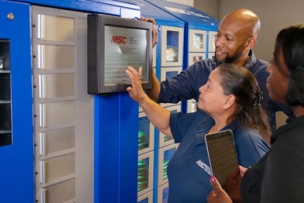With factory shutdowns, worker shortages, an ongoing trade war and unpredictable demand, the past few years have revealed troublesome vulnerabilities in manufacturing supply chains.
Fortunately, machine shops both large and small can take a variety of steps to lower the risk that disruptions linked to those weaknesses will lead to stockouts. Here are seven, starting with the heart of any manufacturing business, its software system.
Look in the Mirror
Sometimes, finding the root of supply chain problems begins with looking in the company mirror. Inaccurate forecasting, supplier mismanagement, cycle count errors—these and other all-too-common business mistakes add fuel to the supply chain fire. Fortunately, a well-implemented enterprise resource planning (ERP) system helps to solve such problems.
ERP brings discipline to the shop floor, makes inventory levels and forecasting more accurate and provides the visibility needed to make sound business decisions in a timely manner. If your shop is among the minority of those without an ERP system, this is a good time to literally get with the program.
Make Your MRP Magnificent
Already have an ERP system? That’s good, but now ask whether it provides the desired results. Is it up to date, or was it installed before Y2K? Keeping current on the shop’s software is every bit as important as replacing outdated, inefficient equipment and machine tools.
Whatever its age or capabilities, it’s critical for your material requirements planning (MRP) to have accurate data to support its functions. Do you perform cycle counts? Are your safety stock levels set properly? How about product lead times, preferred suppliers, lot sizes, and all the other planning variables that determine whether supplies arrive at the right time and in sufficient quantities?
Then ask yourself if the bills of materials (BOMs) are correct. Are the manufacturing times accurate, and do employees clock in and out of jobs religiously? If not, the GIGO rule—garbage in, garbage out—will undermine even the best software system. That’s because ERP and its little brother MRP are not “set it and forget it” affairs. They require regular maintenance and attention to detail if they’re to A) reduce or eliminate supply chain difficulties and B) provide maximum return on investment.
Vendor Managed Inventory
Too busy for cycle counts? Don’t want to tie up working capital in safety stocks, or worry about your system’s planning data? Maybe it’s time to hand the responsibility over to someone else. Vendor Managed Inventory (VMI) is a great way to eliminate these hassles.
As its name implies, VMI options such as MSC’s ControlPoint solutions place inventory management burdens on a strategic partner tasked with keeping the shelves stocked. VMI prevents obsolescence, reduces procurement costs, and frees employees to work on more value-added activities.
Success requires the right vendor, however. VMI should be a collaborative effort between the customer and the supplier. There must be complete transparency regarding product costs and handling fees, with easy access to reports, training and mobile apps for the greatest ease-of-use. The vendor should also be open to long-term agreements (LTAs) that help eliminate stockouts and keep costs low.



Talk to Us!
Leave a reply
Your email address will not be published. Required fields are marked *